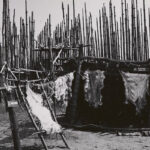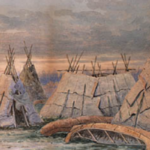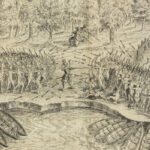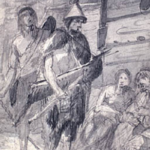Brokenhead Ojibway Nation: A Legacy of Anishinaabe Resilience and Stewardship
The Brokenhead Ojibway Nation, a proud community of the Anishinaabe (Ojibwe) people, is located in southeastern Manitoba, near the shores of Lake Winnipeg. For centuries, the Brokenhead Ojibway Nation has served as a vital cultural, economic, and spiritual hub for the Anishinaabe people. Their history reflects their adaptability and strength in the face of colonization and environmental challenges, as well as their commitment to preserving their rich cultural heritage.
Ancient Origins: Anishinaabe Migration and Settlement
The Brokenhead Ojibway Nation traces its roots to the Anishinaabe peoples, whose ancestral lands extended across the Great Lakes region and into the prairies and boreal forests of present-day Canada. The Anishinaabe followed the Midewiwin prophecy, which directed them westward in search of the land where “food grows on water,” a reference to wild rice. By the late 17th century, the Brokenhead Ojibway people had established themselves along the Brokenhead River and Lake Winnipeg.
The waterways of the region provided the community with abundant resources, including fish, waterfowl, and wild rice. These resources not only sustained the community but also became central to their cultural practices and economic activities. The Anishinaabe developed extensive knowledge of the local ecosystems, which informed their hunting, fishing, and agricultural practices.
Anthropologist Robin Ridington, in Trail to Heaven: Knowledge and Narrative in a Northern Native Community, writes, “The Anishinaabe people’s settlement in southeastern Manitoba was deeply intertwined with their understanding of and respect for the land and water.”
Governance and Social Structure
The Brokenhead Ojibway Nation, like other Anishinaabe communities, followed traditional governance structures rooted in consensus and collective responsibility. Chiefs and councils were chosen for their ability to lead with wisdom and fairness, while elders provided guidance based on their extensive knowledge of oral traditions, laws, and spiritual teachings.
Seasonal gatherings and ceremonies reinforced social bonds and cultural identity. The Midewiwin Lodge, a cornerstone of Anishinaabe spiritual practice, played a central role in maintaining the community’s cultural and spiritual health.
Historian Sarah Carter, in Lost Harvests: Prairie Indian Reserve Farmers and Government Policy, observes, “The Anishinaabe governance system reflected a balance between individual autonomy and collective well-being, emphasizing harmony within the community and with the natural world.”
First Contact and the Fur Trade
The Brokenhead Ojibway people’s first interactions with Europeans occurred during the fur trade era in the 17th and 18th centuries. The Hudson’s Bay Company and North West Company established trading posts along Lake Winnipeg, and the Brokenhead Ojibway became key players in this emerging economic network. They supplied furs, wild rice, and fish to traders in exchange for European goods such as metal tools, firearms, and textiles.
While the fur trade introduced new opportunities, it also brought challenges. The overharvesting of fur-bearing animals and the introduction of European diseases, such as smallpox and measles, disrupted traditional ways of life and significantly reduced Indigenous populations.
Historian Bruce Trigger, in Indigenous Peoples of Canada, notes, “The fur trade brought profound changes to Indigenous communities, integrating them into global markets while exposing them to new vulnerabilities.”
Treaty 1 and the Creation of the Reserve
In 1871, the Brokenhead Ojibway Nation became a signatory to Treaty 1, the first of the numbered treaties between the Crown and Indigenous peoples in western Canada. Treaty 1 was intended to establish a framework for coexistence, with the Crown promising education, healthcare, and protection of hunting and fishing rights in exchange for land.
For the Brokenhead Ojibway Nation, the treaty was seen as a means of securing their traditional way of life while adapting to the pressures of settler expansion. However, like many other treaties, its implementation often fell short of its promises. The creation of reserves under the Indian Act confined the Brokenhead Ojibway people to a fraction of their traditional territory, disrupting their access to important resources and sacred sites.
Historian Margaret Conrad, in A Concise History of Canada, writes, “The promises of Treaty 1 were overshadowed by systemic inequities and policies of assimilation, which sought to marginalize Indigenous communities.”
The Impact of Residential Schools
The establishment of residential schools in the late 19th and early 20th centuries had a profound impact on the Brokenhead Ojibway Nation. Children were forcibly removed from their families, prohibited from speaking their language, and subjected to harsh assimilation policies. The loss of language and cultural practices caused by these schools created intergenerational trauma that is still felt today.
Despite these challenges, the Brokenhead Ojibway Nation has worked tirelessly to heal from the legacy of residential schools. The community has been a leader in cultural revitalization, focusing on the restoration of Anishinaabemowin and traditional ceremonies.
Resilience and Cultural Revitalization
The Brokenhead Ojibway Nation has demonstrated remarkable resilience in preserving their cultural identity and addressing the challenges of colonization. Efforts to revitalize Anishinaabemowin, restore traditional practices, and reclaim sacred spaces have been central to their resurgence. Educational programs, cultural workshops, and land-based learning initiatives ensure that future generations remain connected to their heritage.
In recent decades, the Brokenhead Ojibway Nation has also been at the forefront of treaty rights advocacy. Legal challenges and negotiations have led to greater recognition of their rights and access to resources. These efforts reflect the community’s commitment to self-determination and cultural preservation.
Environmental Stewardship
The Brokenhead Ojibway Nation has long been a steward of the Brokenhead River, Lake Winnipeg, and the surrounding forests. Their traditional ecological knowledge informs their practices in fishing, hunting, and land management. The community has taken an active role in addressing environmental challenges, such as water pollution and habitat loss, to ensure the sustainability of their lands for future generations.
In The Resettlement of British Columbia, historian Cole Harris notes, “The environmental stewardship of Indigenous communities like the Brokenhead Ojibway Nation reflects their deep understanding of the interconnectedness of cultural and ecological health.”
Brokenhead Ojibway Nation Today
Today, the Brokenhead Ojibway Nation is a thriving community that blends traditional practices with modern governance and economic development. The community has invested in renewable energy, housing, and education, reflecting its commitment to sustainability and self-determination.
Annual events, such as the Brokenhead Powwow, celebrate the community’s heritage and provide opportunities for members and visitors to engage with Anishinaabe traditions. Partnerships with universities, governments, and environmental organizations highlight the Brokenhead Ojibway Nation’s innovative approach to reconciliation and nation-building.
A Legacy of Strength and Renewal
The history of the Brokenhead Ojibway Nation is a testament to their resilience, adaptability, and commitment to preserving their heritage. From their role in the fur trade and treaty-making to their leadership in cultural revitalization and environmental stewardship, the Brokenhead Ojibway people have maintained their identity and place within Canada’s evolving landscape.
As Chief Deborah Smith stated in a 2021 interview, “Our story is one of pride, resilience, and a commitment to honouring our ancestors while building a brighter future for our children.”
References
- Carter, Sarah. Lost Harvests: Prairie Indian Reserve Farmers and Government Policy. McGill-Queen’s University Press, 1990.
- Conrad, Margaret. A Concise History of Canada. Cambridge University Press, 2012.
- Fisher, Robin. Contact and Conflict: Indian-European Relations in British Columbia. UBC Press, 1997.
- Ignace, Marianne and Ronald E. Ignace. Keeping the Stories Alive: Language, Land, and Culture in Indigenous Communities. University of Toronto Press, 2008.
- Harris, Cole. The Resettlement of British Columbia: Essays on Colonialism and Geographical Change. UBC Press, 1997.
- Trigger, Bruce G. Indigenous Peoples of Canada. McGill-Queen’s University Press, 1992.
- Brokenhead Ojibway Nation. Guardians of the Waterways: The History and Culture of Brokenhead Ojibway Nation. Brokenhead Publications, 2015.
- Smith, Deborah. “Rebuilding and Resilience: The Future of Brokenhead Ojibway Nation.” CBC News, 2021.
- Treaty 1 Elders. Voices of the Plains: Stories from Treaty 1 Communities. University of Manitoba Press, 2005.
- Ridington, Robin. Trail to Heaven: Knowledge and Narrative in a Northern Native Community. Douglas & McIntyre, 1988.



